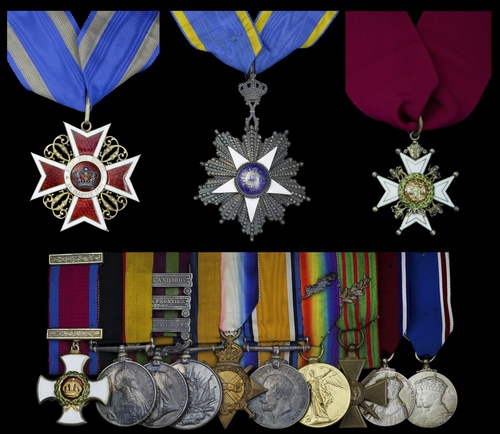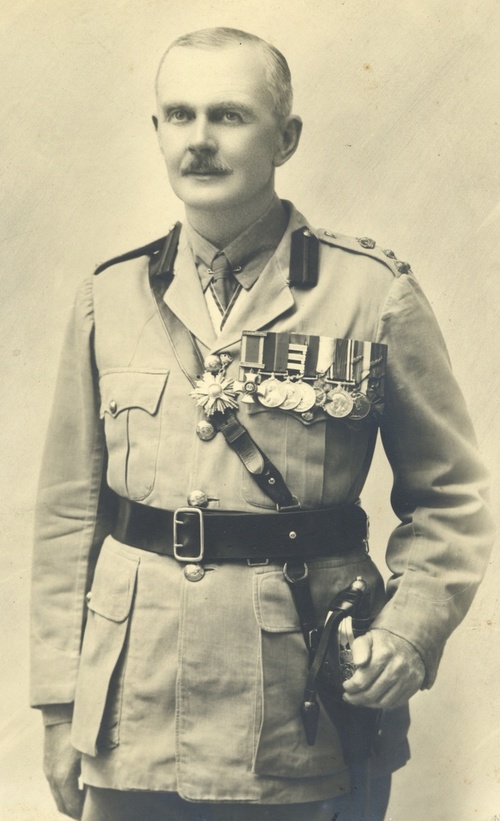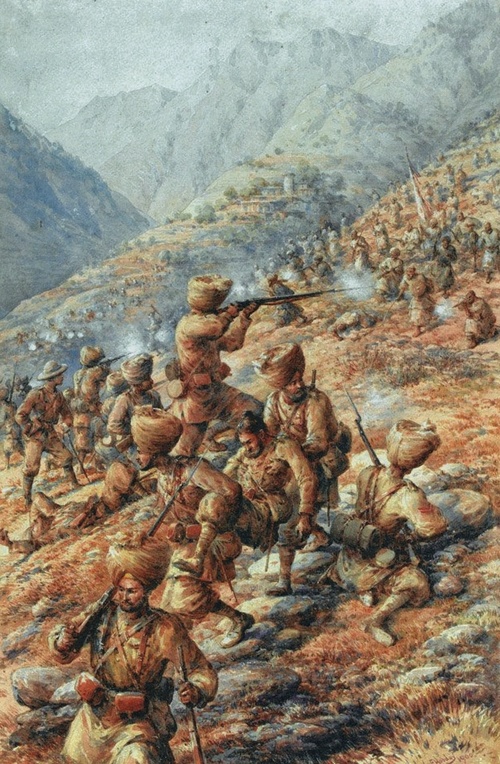Auction: 19001 - Orders, Decorations and Medals
Lot: 543
Sold by the Estate of a Direct Descendent
An impressive C.B., Egypt Operations D.S.O. group of thirteen awarded to Brigadier-General G. R. Cassels, Indian Army, who served in the Sudan and endured a brace of wounds on the North West Frontier of India, one of which was notably covered at length by Winston S. Churchill in The Story of the Malakand Field Force
Returned to the field during the Great War as Commandant of 1/123rd Outram's Rifles, he rose and rising to the command of the 31st Infantry Brigade in Egypt and 20th Infantry Brigade in India.
The Honourable Order of the Bath, C.B. (Military) Companion’s neck badge, silver-gilt and enamel; Distinguished Service Order, G.V.R., silver-gilt and enamel, with its Garrard case of issue; Queen's Sudan 1896-98 (Lieut: G. R. Cassels, 35: Sikh B. Inft:); India General Service 1895-1902, 3 clasps, Waziristan 1901-2, Punjab Frontier 1897-98, Malakand 1897 (Lieut. C. [sic] R. Cassels. 35 Sikhs.), clasps in this order as worn; Khedive's Sudan 1896-1908, no clasp (Lieut: G. R. Cassels. 35th. Bl. Infy.); 1914-15 Star (Lt-Col. G. R. Cassels. I.A.); British War and Victory Medals, with M.I.D. oak leaves (Lt. Col. G. R. Cassels.); France, Croix de Guerre, with Palme upon riband, dated '1914-1918'; Jubilee 1935; Coronation 1937; Egypt, Kingdom, Order of the Nile, Commander's neck Badge, silver-gilt, silver and enamel; Romania, Kingdom, Order of the Crown, Commander's neck Badge, silver-gilt and enamel, the breast Medals mounted court-style as worn by Ranken & Co. Ltd, India with the exception of the Jubilee and Coronation Medals, D.S.O. with pin adapted for mounting, obverse centre depressed, otherwise good very fine (13)
C.B. London Gazette 1 January 1925 (Commander, 20th Indian Infantry Brigade).
D.S.O. London Gazette 1 January 1919 (Egypt - 1/123rd Outram's Rifles).
Croix de Guerre London Gazette 8 March 1920.
Order of the Nile London Gazette 9 November 1918.
Order of the Crown, permission to wear granted 12 January 1923:
'In connection with the visit of Prince Carol of Romania to Egypt in 1920.'
Gilbert Robert Cassels was born in 1870 and educated at Elizabeth College, Guernsey and the Royal Military Academy, Sandhurst. Commissioned 2nd Lieutenant in the Worcestershire Regiment in 1889, he was transferred to the Indian Army in 1892, joining the 35th Sikhs. It was with the Sikhs that he served with distinction during the Dongola Expedition, before moving to India. It was on the North West Frontier that Cassels was severely wounded on 16 September 1897 in the Mahmud Valley. Winston S. Churchill in Chapter 11 of The Story of the Malakand Field Force: An Episode of Frontier War provides details of the action:
'From far up the hillsides men came running swiftly down, dropping from ledge to ledge, and dodging from rock to rock. The firing increased on every hand. Half a company was left to cover the withdrawal. The Sikhs made excellent practice on the advancing enemy, who approached by twos and threes, making little rushes from one patch of cover to another. At length a considerable number had accumulated behind some rocks about a hundred yards away. The firing now became heavy and the half-company, finding its flank threatened, fell back to the next position.
A digression is necessary to explain the peculiar configuration of the ground.
The spur, at the top of which the village stands, consists of three rocky knolls, each one higher than the other, as the main hill is approached. These are connected by open necks of ground, which are commanded by fire from both flanks. In section the ground resembles a switchback railway.
The first of these knolls was evacuated without loss, and the open space to the next quickly traversed. I think a couple of men fell here, and were safely carried away. The second knoll was commanded by the first, on to which the enemy climbed, and from which they began firing. Again the companies retired. Lieutenant Cassels remained behind with about eight men, to hold the knoll until the rest had crossed the open space. As soon as they were clear they shouted to him to retire. He gave the order.
Till this time the skirmishing of the morning might have afforded pleasure to the neuropath, experience to the soldier, “copy” to the journalist. Now suddenly black tragedy burst upon the scene, and all excitement died out amid a multitude of vivid trifles. As Lieutenant Cassels rose to leave the knoll, he turned sharply and fell on the ground. Two Sepoys immediately caught hold of him. One fell shot through the leg. A soldier who had continued firing sprang into the air, and, falling, began to bleed with strange and terrible rapidity from his mouth and chest. Another turned on his back kicking and twisting. A fourth lay quite still. Thus in the time it takes to write half the little party were killed or wounded. The enemy had worked round both flanks and had also the command. Their fire was accurate, two officers, the Subadar Major, by name Mangol Singh, and three or four Sepoys ran forward from the second knoll, to help in carrying the wounded off. Before they reached the spot, two more men were hit. The Subadar Major seized Lieutenant Cassels, who was covered with blood and unable to stand, but anxious to remain in the firing line. The others caught hold of the injured and began dragging them roughly over the sharp rocks in spite of their screams and groans. Before we had gone thirty yards from the knoll, the enemy rushed on to it, and began firing. Lieutenant Hughes, the Adjutant of the regiment, and one of the most popular officers on the frontier, was killed. The bullets passed in the air with a curious sucking noise, like that produced by drawing the air between the lips. Several men also fell. Lieutenant-Colonel Bradshaw ordered two Sepoys to carry the officer’s body away. This they began to do. Suddenly a scattered crowd of tribesmen rushed over the crest of the hill and charged sword in hand, hurling great stones. It became impossible to remain an impassive spectator. Several of the wounded were dropped.
The Subadar Major stuck to Lieutenant Cassels, and it is to him the Lieutenant owes his life.'
Recovered from his wound, Cassels was wounded for a second occasion in Waziristan in 1901, latterly serving on the Staff in the operations against the Darwesh Khel-Waziris. Entered to the Staff College, Quetta, he was posted General Staff Officer 2nd Class and promoted 1st Class in 1914. At the outbreak of the Great War he was serving with the Secunderabad Division in Mesopotamia, joining 1/123rd Outram's Rifles, whom he served with in Egypt and Palestine. By the Armistice, he was Commandant of the Regiment and had a brace of 'mentions' (London Gazette 14 June 1918 & 22 January 1919, refer.) together with a well-deserved D.S.O. to add to his laurels. Appointed Brigadier-General in command of the 31st Infantry Brigade in Egypt in 1920, his final posting was as Colonel Commandant, 20th Indian Infantry Brigade, 1920-25. Cassels retired in 1927 and died at home in Bungay, Suffolk on 13 October 1951.
Sold together with a quantity of original material comprising:
(i) Elizabeth College, Guernsey gold prize medal, 50mm, the reverse engraved 'Gilbertus R. Cassels. XV. Annos Natus.'
(ii) A fine portrait of the recipient wearing his Medals.
(iii) The bestowal document for the C.B..
(iv) The bestowal document for the D.S.O..
(v) The Mention in Despatch Certificates (2).
(vi) The bestowal document for the Order of the Nile, in named envelope.
(vii) The bestowal document and letter of Permission to Wear for the Order of the Crown.
(ix) A quantity of riband bars, rank insignia, a fraternal neck Badge, a Primrose League Medal and Masonic Badge.
For the recipient's miniature dress medals, please see Lot 1021.
Subject to 20% VAT on Buyer’s Premium. For more information please view Terms and Conditions for Buyers.
Sold for
£7,500









